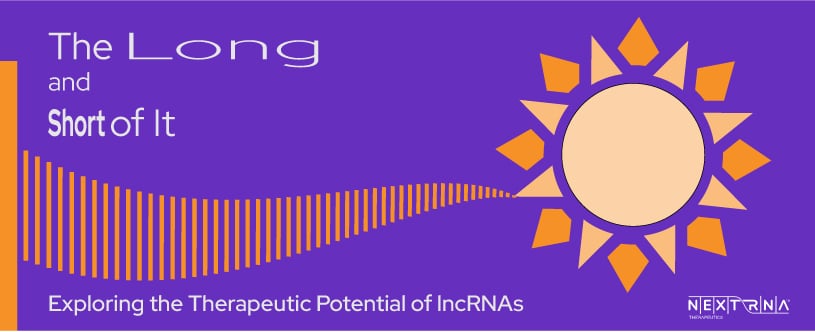How would you compare the advancement of the mRNA space to the lncRNA space?
We had very unique circumstances that accelerated mRNA. But there are years and years of basic research that have gone into the mRNA space. The general public might think it just popped out of nowhere, but it had been worked on aggressively for years. And it was serendipitous that we could then quickly pivot what was being developed for infectious disease and cancer vaccines into a vaccine for the SARS-Cov-V-2 virus. I think the mRNA space was also able to accelerate because of the huge investment into it.
lncRNAs are at a very early stage. So, there is a lot of basic research that still needs to go into them, and that basic research also requires investment. I’m excited to see the technological advances that are coming along that allow for more rapid, high-throughput approaches that will help us understand the function of lncRNAs much faster than, say, 10 years ago. And then I also think there are constant impressive breakthroughs in chemistry that we will need in the RNA space overall to make RNA more therapeutically tractable. So, we need continued technological advances, chemistry breakthroughs and investment.
How do you see academia and industry working together to accelerate the lncRNA space?
Being an academic, I’m obviously all about basic research. But then I always want these things to be usable for the downstream effects. For example, I’m studying sepsis and autoinflammatory diseases. And I’m studying lncRNAs because I really believe they are key to understanding what’s going on with inflammation. And so how is my work going to ever translate to patients without working a bit more closely with industry? What we’re working on in our lab eventually needs to move out and be taken up by industry. And, personally, I think why the lncRNA space is so exciting and should be exciting to industry is that lncRNAs are really cell type-specific and context specific.
Can you explain how lncRNA’s specificity translates therapeutically?
I think the specificity translates for both therapeutic and diagnostic applications. If you have these components that are very specific, especially for complex diseases like inflammatory diseases that are incredibly hard to diagnose, we really want to exploit those.
What we’re seeing, and the reason why you see so many more lncRNAs every time we update GENCODE, is because we’re sequencing more and more different cell types, different disease types, and we’re identifying more of these genes.
Are there standout therapeutic areas in the lncRNA space?
The most advanced field in lncRNA research is cancer. We consider cancer as biology gone wrong. And all of these lncRNAs, you’ll see them popping up as these major signatures of specific types of cancer. I believe these lncRNAs probably have a normal biological role that’s now dysregulated in a particular type of cancer. So, say, for example, something that’s normally important in a macrophage, which is what we work on in our lab, is now suddenly turned on in prostate cancer. And it’s doing things in those cells that it should not be doing because it should be doing them in a macrophage. So, we think that there are lncRNAs that are going to be driving phenotypes – but it’s still really early.
Because they’re so cell-type specific, no matter what condition or disease you’re talking about, if you actually study the lncRNAs, you will see unique features and unique things happening. So, I think we have only scratched the surface of the role lncRNAs play in disease. I think there’s been a lot of skepticism over what their role is just because we haven’t done the experiments yet to figure out what’s doing what.
Do you find a lot of collaboration in the lncRNA space?
Definitely. In fact, that is one of the reasons why I was most excited about going into and staying in this space. I’m an immunologist, and immunology is one of the most rapid-moving fields, where there are tons of labs all working on the same thing. And that was one thing I did not want to be in the center of when I was doing my postdoc. That was when I moved into this space. I think because lncRNAs are so technically challenging, and it’s not easy, straightforward path to characterizing lncRNAs, it’s still a relatively small community, but a super collaborative one. And, actually, there are a lot more people now. In the early days, it was a limited number of labs that were working on it. Now the labs that have been working on this for 25 years are like, “Welcome to the party!”
Can you describe some of the early work in the lncRNA space?
Well, I’ve loved the field from the very beginning. Some of the biggest pioneers in the field are women, which was something I had not seen, 20 years ago anyway, in the immunology field. Women like Jeanie Lee and Edith Heard who have been working on the lncRNA XIST forever. The first lncRNA-related conference I went to, they were the two keynote speakers, and I thought, “Wow, this is amazing!”
Can you explain XIST and its significance?
A lot of skepticism early on about lncRNA centered on how could something that has such low abundance mean anything – even as little as one copy per cell?
XIST is really the poster child for demonstrating this. It’s one of the early lncRNAs – it’s been studied intensely for 25 years. It’s the mother of all lncRNAs, this massive beast of a lncRNA that’s 20 kb [kilobase]. People describe XIST as ‘punching way above its weight’ because such a small amount of this lncRNA silences the entire X chromosome.
It seems to be for the lncRNAs where we already know what their function is, similar to XIST, they’re working very locally, in which case, you only need a couple copies; you don’t need loads. It takes energy to make these things. So, your cells aren’t going to waste that energy. They only make what’s needed. And then some lncRNAs can work very much on their neighbors. You might just need a copy to be made to pull them together to do their job. We now have strong evidence that these very lowly expressed transcripts are doing big jobs, again, this idea of punching above their weight.
How do you see the lncRNA space advancing in the next 5 – 10 years?
I think now our technology is getting better and better. That’s going to make it easier to say, “OK, there are tens of thousands of these. Let’s rapidly figure out what’s actually important.” I see more and more screens happening already, and I think that will only continue. But I think in order to do a good screen and an accurate screen that’s really informative we will need to know exactly the architecture of these genes. And I think that’s coming along with things like long-read sequencing. And, so, in the next five, 10 years, I think we’re going to have all of that information. And with more information, you then have to figure out, functionally, why is a given lncRNA important, or not.
And then on the therapeutic side, we will need improvements in our chemistry of how we can go after these things in a specific way. How can we therapeutically do a better job at targeting RNA? I think that hurdle needs to be met for my field of immunology – which is how would I solve sepsis, for example? It needs to be something that can systemically work. Delivery is a massive challenge – the biggest challenge I would say. But I’m optimistic that’s just going to be solved through a chemistry breakthrough.

